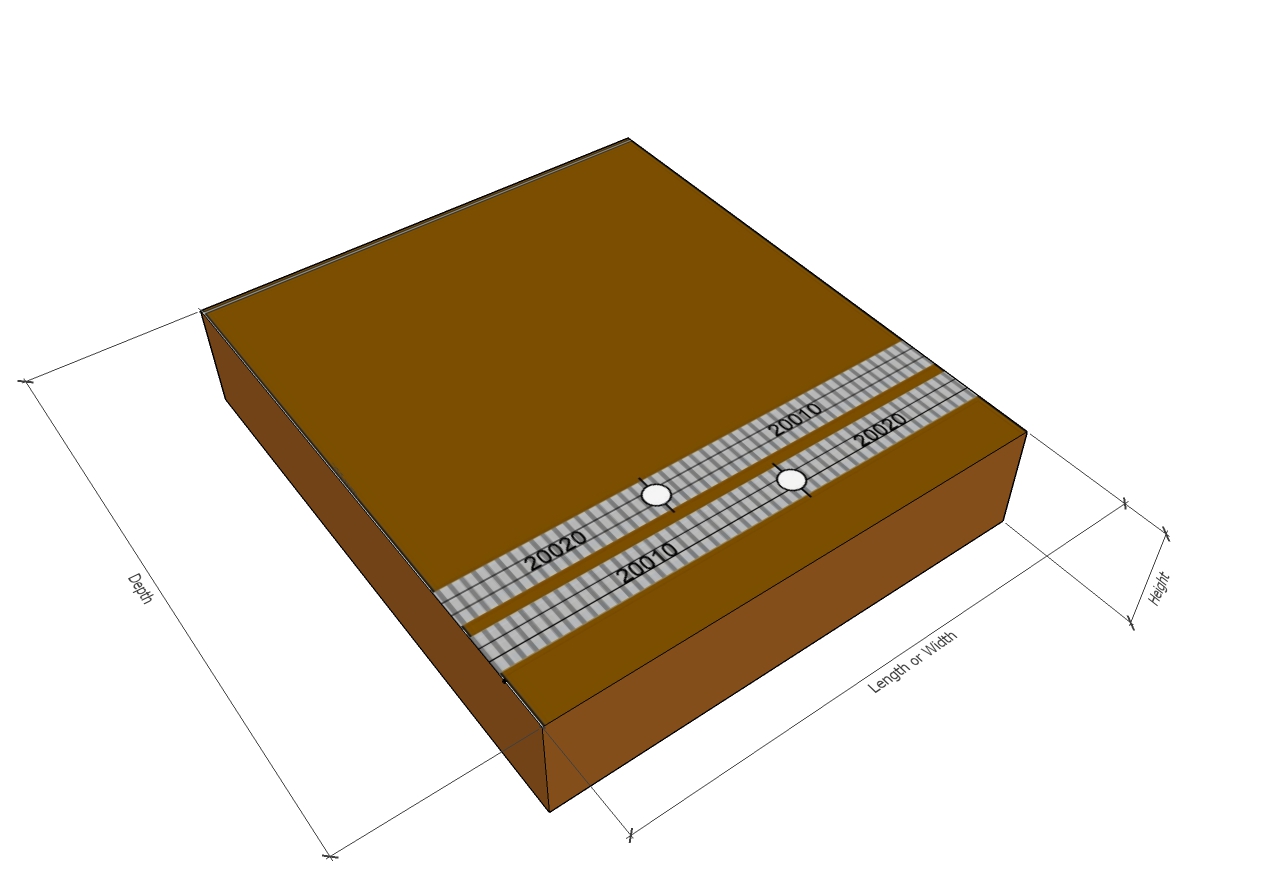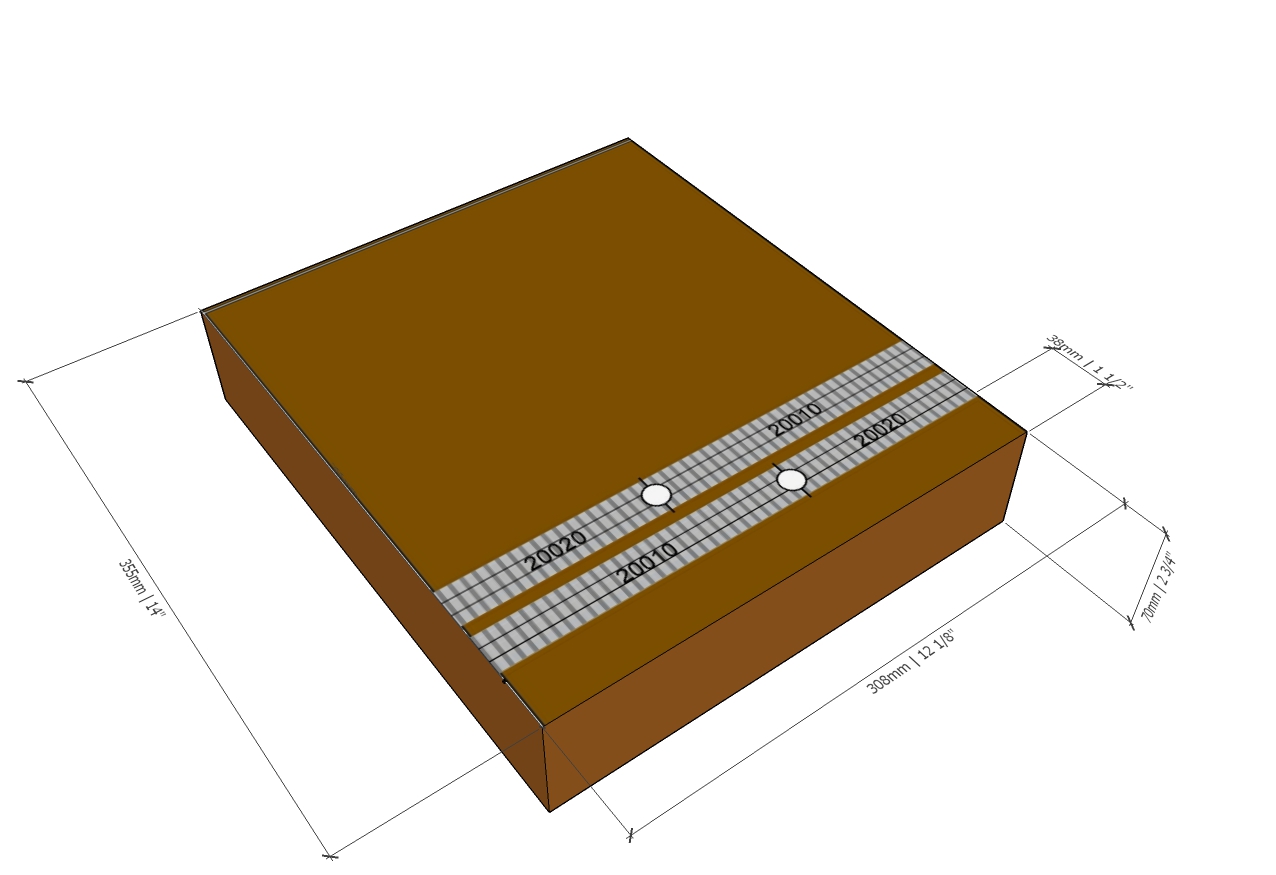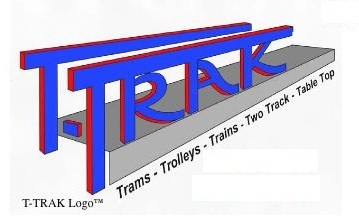This website has been archived from TrainWeb.org/ntxttrak to TrainWeb.US/ntxttrak.
T-Trak Standards
One of the beautiful aspects of T-Trak is the simplicity of the specifications. In actuality, there
are very few "formal" specifications for a T-Trak module, however, if those few specifications are followed,
all T-Trak modules are compatible with each other. Also, most, but not all T-Trak modules are built to N-Scale specifications.
The following paragraphs will discuss N-Scale T-Trak dimensions but a table for other scales is provided at the bottom of this
page. In order to begin the conversation on standards some definitions
must be established. The "length or width" of the module is the axis parallel to the track. The terms length and width
are used interchangeably in T-Trak. The "depth" of the module is the dimension perpendicular to the track and is the distance
from the front (nearest the track) of the module to the back. The "height" of the module is measured from the bottom
of the module to the base of the track. |

|
|
As previously mentioned, there are few formal specifications. However, there are some informal specifications that will
be noted in this document. The first item in the list of formal T-Trak specifications is that the track at the module edges must be Kato Unitrack.
Modules in a layout are not clamped or bolted together in any fashion. The only thing that holds the modules together
in a layout are the the Kato unijoiners. It is acceptable to use track from other manufacturers between the Kato Unitrack interfaces,
however, most T-Trak builders use Kato Unitrack exclusively on their T-Trak modules. Builders must ensure the trackwork
on their modules will not cause issues while running trains. The first time T-Trak builder is advised to use Kato
Unitrack exclusively on their first few modules. The use of Kato track created an early "informal" standard for the length of track on a module to be 310mm (which is 12.2"). A module of this size is typically referred to as a "single". A module with 620mm of track is referred to as a "double". Naturally, those with 930mm of track (3 x 310mm) are known as "triples" and, yes, there are "quads" (4 x 310mm) and even longer T-Trak modules, but they stray from the small, easy to store, easy to transport tenants that make T-Trak attractive. It is advisable that all track on straight modules be built as a multiple of 310mm units of track for reasons of compatibility. The reason this is advised is because most T-Trak layouts consist of a double row of modules on a table and a non-standard length module on one side will not permit the loop to be closed. In order for a non-standard lenghth module to be used, another module of equal length must be built and used on the other side of the table, or the layout must be constructed as a single row of modules with return loops on each end. While a non-standard length T-Trak module can be constructed, the builder should recognize that doing so may limit the usability of that module in a multi-person, multi-club layout. While on the subject of Kato Unitrack, it should be noted that Kato produces straight track in increments of 62mm. (i.e. 62mm, 124mm, 186mm, 248mm and the double crossover is 310mm) and straight track is packaged four pieces to the package so for most typical track combinations (e.g. 124+186; 248+62) two packages of track are enough for two single modules or one double module. There are other combinations that create 310mm of track but they will require more pieces. Since Kato track is measured in metric units it is easiest to build modules using metric measurements. |
|
| There are multiple ways to build a T-Trak module but the most common is the box method. This is basically a lidless, inverted box. For a module of single length (i.e. 310mm of track), the box should be no more than 308mm (12 1/8") wide. This gap provides for 1mm of track overhang on each side of the module. This 1mm overhang (or more) is part of the formal T-Trak standards. It was implemented to allow flexibility with connecting to other modules that may not be built squarely, or for those that warped or flexed. The formal standard height of the module is 70mm (2 3/4") and is adjustable to a height of 100mm (4") by utiliizing leveling bolts. The height measurement is from a flat surface to the base of the Kato track. There is no formal specification for the depth of a module. The original T-Trak modules and subsequent kits from Lee Monaco-Fitzgerald were 210mm (8 1/4") deep. However, the depth for modules varied by |

|
| builder depending on the desire for scenery space and available building materials. The general consensus among the T-Trak community is that a module should be no deeper than 355mm (14"). In a typical double row, oval layout this permits a small gap between the backs of modules. Since this is an informal maximum there is some flexibility with this dimension. For example, a smaller module could be built and placed opposite a deeper module, however, this arrangement could limit the use of those modules in a multi-person, multi-club layout. The track placement standard for T-Trak modules is a bit unique and is an outcome of the use of Kato Unitrack. The formal offset from the front fascia to the edge of the ballast (not track center) of the front track, or Blue line, is 38mm (1 1/2"). The center to center spacing for the second, or White line can either be 25mm or 33mm. The 25mm spacing was the original specification for T-Trak but is rarely used due to clearance issues on corners with longer rolling stock. Track spacing of 33m is the most common spacing for existing modules and is identical to Kato's double track pieces (e.g. concrete tie track, double cross over, etc.). Regardless of the track spacing, it is imperative that both front and back tracks are square with respect to each other and the box upon which they are affixed. It is a best practice to use Kato's double track sections as alignment tools when affixing track to a module. | |
|
One of the most discussed T-Trak standards is the wiring standard. The wiring specification is a formal standard. For modules wired for track power and using standard Kato connectors, the specification is that the rails, beginning with the front rail on the front track, be wired in a Blue, White, White, Blue order. This is also known as "blue to the outside". This is another case of Kato track affecting the development of T-Trak standards. When the track spacing was originally 25mm, the Kato feeder tracks interfered when physically placed for the same "polarity". In order for both the inner and outer line to properly fit, the feeder track on the inner line was physically reversed, thus reversing the polarity of that line. At the time, this was considered to be a benefit because it permited running a train on each loop (inner and outer) in opposite directions with one DC throttle. |
picture of wiring? |
| Regardless of the historical reasoning, the standard has been in place since the beginning and has not changed. The proper way to reverse the polarity for the White line is to do so at the power pack and not at the module. All modules that feature a power drop should be wired to the specification and have the Kato power connector. | |
T-Trak Standards for each Scale
| T-Trak-Z | T-Trak-N | T-Trak-HO | T-Trak-S | T-Trak-O | |
| Single Module Track Length | 330 mm | 310 mm 12.2 " |
492 mm 19.37 " |
30 " | 40 " |
| Single Module Length | 328 mm 12.9375 " |
308 mm 12.125 " |
486 mm 19.125 " |
29.875 " | 39.875 " |
| Maximum Module Depth | 286 mm 11.25 " |
355 mm 14 " |
711 mm 28 " |
24 " | 24 " |
| Common Corner Module Track Radii | 195 mm | 220 mm | 282 mm | 315 mm | 550 mm | 610 mm | 20 " | 25 " | 36 " | 48 " |
| Corner Module Dimensions | 295 x 295 mm 11.625 x 11.625 " |
365 x 365 mm 14.375 x 14.375 " |
711 x 711 mm 28 x 28 " |
28 x 28 "Â | 28 x 28 " |
| Height (all modules) | 70-100 mm 2.7 5- 4.0 " |
70-100 mm 2.7 5- 4.0 " |
70-100 mm 2.7 5- 4.0 " |
2.75 - 4.0 " | 2.75 - 4.0 " |
| Track Interface | Micro Trains | Kato Unitrack | Kato Unitrack | MTH S-Trax | Lionel Fastrack |
| Blue Line Track Offset | 76 mm 3 " |
38 mm 1.5 " |
83 mm 3.25 " |
5 " | 4 " |
| Track Spacing | 25 mm | 33 mm | 60 mm | 5 " | 6 " |
| Electrical Connections | ? | BWWB | BWWB | ? | ? |















